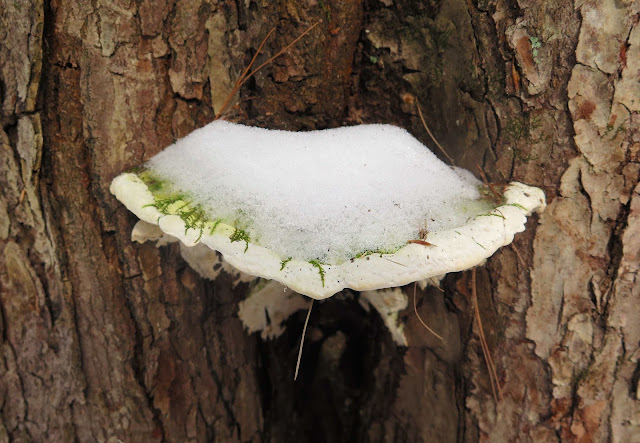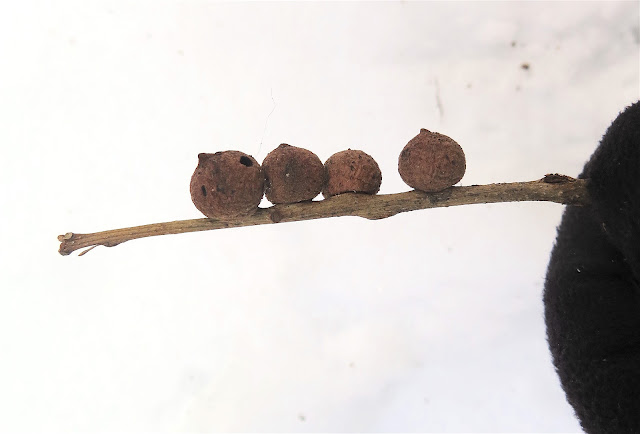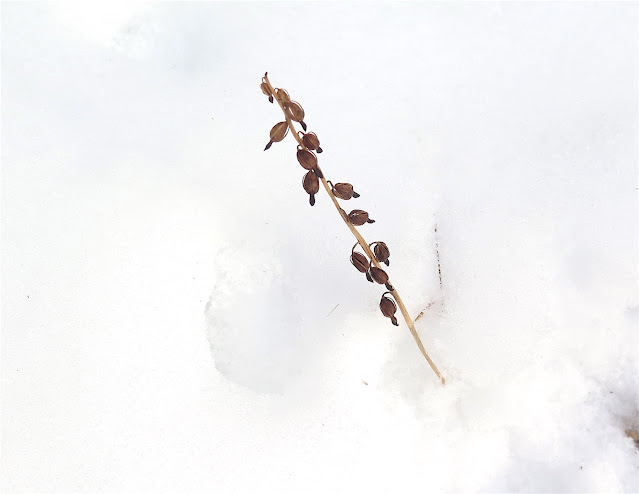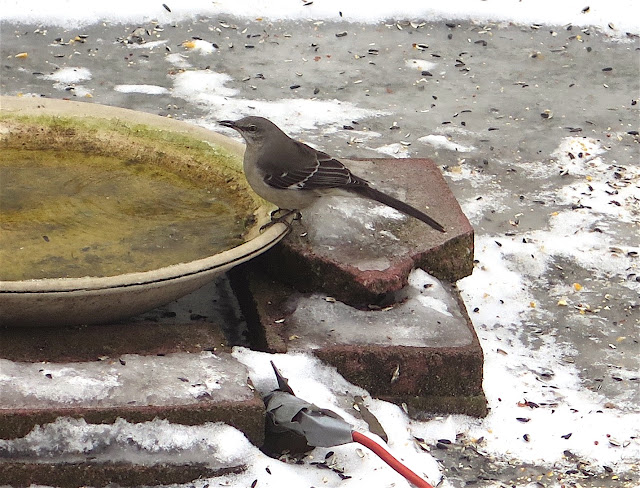You can BET we got bundled up, my Thursday Naturalist friends and myself this week! Thursday brought us another 10-below-zero dawn, although the thermometer did manage to creep up to 6-above by the time our smaller-than-usual group gathered at the Usher's Road State Forest Trail at 10am. You can't see me in this photo, but even if I had been in it, you could not have recognized me, encased to my eyes as I was, in my "walking sleeping-bag" (a shin-length down coat) and with fuzzy scarves wrapping my head. Every pocket held a hand warmer, as much to keep my battery-operated camera alive as to warm my thickly mittened hands.

The Usher's Road State Forest Trail lies a few miles south of Round Lake, and it offers a nearly-two-mile loop trail through forest and wetland remarkable for the presence of many enormous White Pines. We also passed through a Hemlock-dominated section with trees that were almost as large, their branches alive with twittering Chickadees ripping the cones apart to feed on the seeds. Note the scarcity of understory trees, so typical for forests of this age.
Bright sunshine helped to warm us a bit, but the most exciting reward of that sunlight was to dazzle us with sparkling snow, the sparkles glinting all the colors of the rainbow. This is a very difficult effect to capture in a still photo, but by boosting the saturation of this shot, I did manage to make visible those colors, even though the brilliant whiteness of the snow got diminished in the process. Just try to imagine how gorgeous it was, the colors dancing and glittering with every movement of our heads.
With so few herbaceous plants to attract our interest this time of year, the persistent fungi stand out to draw our attention -- especially when they are as large, intact, and handsome as this stack of polypore shelf fungi. Since many fungi lose much of their distinguishing coloration in winter, I did not even attempt to put a name to this pale-ivory one, other than to call it "beautiful."
This white shelf fungus had acquired some pretty tracery of a vibrant green moss on its cap, mostly hidden now beneath a fluffy cap of snow.
These small round galls lined up like little birds perched on a twig were as hard as nuts, so I knew they were not the puffball fungi they resembled before I looked more closely. Each had at least one small round hole in it, which could either have been a larva's exit hole or the entrance hole drilled by the larva's predator.
As we passed among towering Hemlocks, we noticed many patches of the remnants of shredded Hemlock cones, both the scales that covered the tiny winged seeds and a few of the seeds themselves. Would the Chickadees hopping about in the upper branches have done this deed, or had forest-dwelling rodents had a go at the cones that had fallen to the ground?
Here was a fallen American Beech twig lying on the snow, with two beechnuts still attached, the nuts inside the burs still intact. It seemed very odd to me that the nuts had not been consumed long ago!
The numerous webby patches of Frullania liverwort are so ubiquitous on the smooth-barked trees of any woods around here that they usually go unnoticed. But this particular patch was such a vivid green (most Frullania is a dark brown) that it looked quite lovely against the golden bark of this tree. (I confess I have not yet learned to distinguish one Frullania species from another. Sorry!)
At least, I usually DO recognize an orchid when I see one! And the pods of this small orchid, each plump oval pod with a withered floral part protruding from the tip, definitely said "Coralroot" to me. Ah, but which species? After showing this photo to two of my orchid-expert friends, I am happy to report that they verified my hunch that these were the winter remains of an Autumn Coralroot (Corallorhiza odontorhiza).
We managed to emerge from the woods unscathed by frostbite, looking forward to meeting again next Thursday, when I hope to lead my friends out on the frozen surface of Lake Bonita to explore the little islands I described in my previous blog post. I hope it will be a bit warmer then, but still cold enough to preserve the thickness of the ice.
It was still very cold this morning (Friday) when I was surprised to see this Mockingbird drinking from our heated birdbath. I'm not used to seeing this species in our backyard at any time of the year. But since, after several nights of sub-zero cold, our birdbath may provide the only liquid water available to wildlife for miles around, I suppose I should not be surprised by this, or any other, unusual wildlife visitor.











6 comments:
What a time you all had !
I do have photos of you in your "sleeping bag" coat if anyone wants to see them (ha).
There are several places I have seen Mockingbirds in winter, for the past few years, it may be a first for your neighborhood though -- the common thread in where I see them is WATER -- so many put out seed but don't realize how vital water is for birds, especially in supercold weather when many of their sources freeze over. Thank you for making sure they have some (unfrozen) water available, your yard might become very popular this year !
Your little round galls are probably either rough oak bullet galls (Disholcaspis quercusmamma) if on swamp white, bur, or overcup oak; or round oak bullet galls (Disholcaspis quercusglobulus) if on white oak (Q. alba). The insects usually emerge in the fall, but that doesn't mean the holes weren't from parasites.
You caught the sparkles! I have tried many times, but only succeeded once. Well done!
You did welll to enjoy the walk with temperatures that low.
The winter woods are as fascinating and beautiful as the forest is at any other time of year, just quite different.
I wrote this today: Feb. 6, 2022 This is a magical morning! The freezing rain storm (ice storm) of two days ago has left a glaze of ice on all the buds, twigs and branches and miniature icicles of each and every tree, shub, forb, and vine in the yard. Overnight the elves decorated every one of them with miniature lights. Mostly bright white; but many colored and these change colors with a slight cocking of one's head: red. blue , or green. It must have been an army of elves; and they didn’t discriminate. The Cherries, Staghorn Sumac, rose bushes, even the White Pines, spruces and Arborvitae were all decorated unsparingly. They did seem to favor the very tall Douglas Fir for it glistened far prettier than any Christmas tree I've ever had. The Elves even covered snow pack with their excess lights. I thougt you had a name for this. Ignore the name, Chuck
Post a Comment